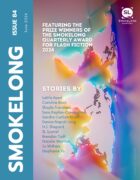The monsters in this piece are never named. What makes them monsters? Can you share about the choice not to name them?
When we’re young, we adopt our parents’ beliefs as our own, accepting them as truths. In this case, the protagonist refers to the people around her as “monsters” because her parents have never felt welcomed amongst them. As the story unravels, though, the “monster” becomes less monstrous as she develops her own relationship to the people she’s grown up around. We can feel her reconsidering her role amongst them as a child who shares their language, their behaviors, and their birthplace. While monster holds monstrous weight in the beginning of the story, I think by the end, the impact of the word is softened, almost to a term of endearment.
While I always knew how I defined the “monsters,” I avoided overtly spelling it out because I wanted to invite the readers to insert their own monster into the story. I liked the malleability that gave the piece.
The question of language as an identification tool comes up repeatedly. Can you share about the role that being able to communicate plays in this story?
Communication is the great connector: It’s what bonds us to others and ties us to a community. Without it, there’s no self-expression, no camaraderie, no storytelling, and no shared experiences. While that alone is interesting to me, I enjoyed going one click further and thinking about the role of a child translator and the pressure that would put on a child. Not only would they have to navigate their own becoming, but also the adult world full of adult burdens and needs. It’s interesting to me to think what impact that responsibility might have on childhood. I imagine there would be great consequences to what’s typically meant to be the most carefree time in one’s life. In this way, communication is about more than just the ability to talk to another person. It’s about dependency, identity, belonging, and childhood innocence.
That ending is full of tension. To me, it both echoes what has come before and surprises the reader. How do you think about the role of endings in a story?
I once heard a quote from Richard Howard about how the last line of a poem should send a lightning bolt back up through the body of the piece. I’ve always thought this applied nicely to the end of short stories as well. I enjoy a surprising ending, even more when it calls back to something referenced early on. For me, returning to the truck gave the piece a circular shape, but also instilled a nice sense of motion.
This ending is about the universal experience of being someone’s child, and the inevitable guilt that comes with knowing that one day you will leave them and break their hearts. When the truck reappears, her guilt lingers in the air, but so does her hope and her excitement for a life free of the burdens that come with being their child. She’s off, and we’re left in the dust of that fast-moving truck. There’s a lot of motion and stillness in that line, and I liked the impact that had.
There is a wonderful degree of specificity to the food items in this story. What’s the role of food here? How do these food items accumulate a sense of tension throughout the piece?
When you’re a child, that desire to belong is especially strong, and things like how you dress, how you speak, and what’s in your lunchbox have a lot to do with where you land on the spectrum of sameness. I wanted to present different foods without commentary, just placing them in the scene with subtle observations to help the audience understand the protagonist’s relationship to them. We can feel how she’s learning to assimilate through food, observing and adopting the ways in which her “monstrous” peers eat. Food equals community when our plates look the same, but it can also equal isolation when our plates look different. In this way, food helped me visualize that tug between belonging and loneliness as the protagonist battles being half of two things.



 Included in the price of SmokeLong Fitness:
Included in the price of SmokeLong Fitness: